The Future of Data Analytics – Data Analytic Trends
Big Data analytics is on the verge of a major transformation. Many of the up-and-coming data analytics trends are the result of multiple revolutionary technologies converging at once. Cloud-based data sources allow companies to leverage internal data with data from social media feeds, SaaS tools, and third-party sources while IoT devices capture insights from objects, environments, and legacy equipment.
Gartner predicts that, by the end of 2024, 75% of organizations will transition away from pilot programs and experiments to fully-operationalized Big Data strategies. This shift stands to increase streaming data and analytics infrastructures by an estimated 500%. As more data sources enter the mix every day, businesses are increasingly looking toward AI, machine learning, and natural language processing to help them quickly identify and act on insights hidden in disparate datasets.
In his article, we explore the technology currently shaping the future of data analytics.
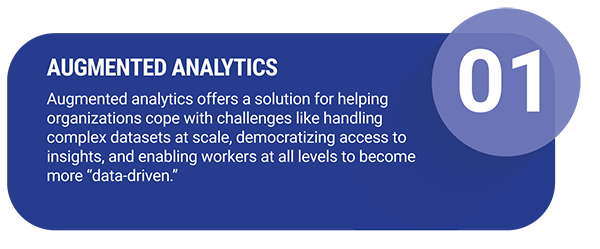
Augmented Analytics Is Making Business Intelligence More Accessible
Augmented analytics is a term coined by Gartner in 2017 that refers to a process of automating insights using natural language processing (NLP) and machine learning (ML). This emerging trend represents the next stage in Big Data and analytics disruption, offering a solution for helping organizations cope with challenges like handling complex datasets at scale, democratizing access to insights, and enabling workers at all levels to become more data-driven. By bringing data science to a broader group of end-users, augmented analytics helps organizations address the growing shortage of skilled workers.
With traditional BI tools, users (typically a data scientist or analyst) needed to have a hypothesis—or at least a general idea—of what they were hoping to find before building a model and running an analysis. With augmented analytics platforms, the built-in AI highlights trends, anomalies, and relationships that users might never think to look for on their own.
Many platforms include capabilities like NLP-based querying, making it easy for users to enter queries using plain language, much like a Google search. They receive responses that recommend next steps and explain the logic used to arrive at that conclusion.
Conversational analytics takes NLP even further, allowing end users to ask questions using voice search and receive a verbal answer through digital assistants or apps. It’s worth noting that while augmented analytics makes business intelligence more accessible to non-technical users, it doesn’t address the data literacy problem, which is something organizations will need to consider as they hire, train, and reskill their workforce.
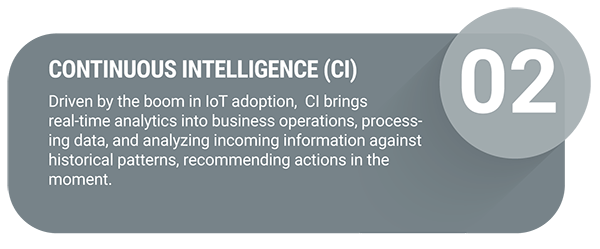
Continuous Intelligence: The Future of Data Analytics Is Real-Time Insights
As IoT adoption continues to explode, continuous intelligence tops the list of new trends in Big Data analytics. The technology brings real-time analytics into business operations by processing data, analyzing incoming information against historical patterns, and recommending actions instantly.
In a recent white paper, ABI Research predicted that we’ll soon see greater adoption of continuous intelligence technologies as streaming analytics and the demand for real-time insights start gaining more traction, and as the ability to extract business value from IoT data continues to grow. According to the report, widespread adoption of continuous intelligence technologies stands to take IoT analytics beyond the operations, maintenance, and control use cases you’ll find in an industrial setting. Soon, we’ll start to see such technologies play a larger role in strategic planning initiatives, driving organizational change in all industries.
As it stands, more vendors are offering out-of-the-box solutions that help brands expand their capabilities—think machine learning algorithms, digital twinning, and data visualizations. What’s more, 5G is making its way to the mainstream (although ABI predicts this won’t happen until 2023), which is likely to drive unprecedented growth in IoT adoption.
While 5G promises high-speed processing, it’s worth noting that the mobile network offers a lot more than a faster connection. Its low-latency, continuous coverage will support technologies like autonomous vehicles, smart infrastructure, and automated public transit systems as well as driving improvements across all sectors. That said, as continuous data streams become more common, Big Data is likely to get a lot bigger, presenting new challenges for brands still trying to become data-driven.
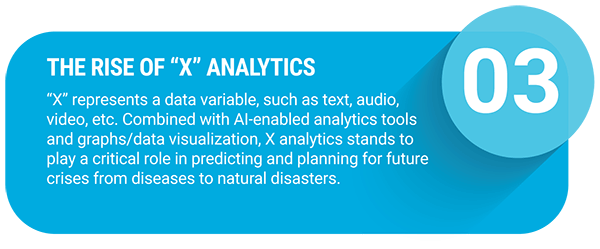
Predictive, Prescriptive, and “X” Analytics Could Help Brands Prepare for the Next Big Crisis
Predictive and prescriptive analytics were already on the rise in 2020. As we continued to deal with the COVID-19 crisis in 2021, the next wave of trends for Big Data analytics focused on helping companies avoid future crises.
We expect platforms that assess risks, economic conditions, and climate trends, and which model different responses to black swan events to grow over the next several years. This is due, in part, to the rise in “X Analytics.”
X Analytics is another Gartner term, where X represents a data variable—either structured or unstructured. Think text analytics, audio analytics, and video analytics. Combined with AI-enabled analytic tools and graphs/data visualization, X analytics stands to play a critical role in predicting and planning for future crises—from diseases to natural disasters.
For example, AI can scour news articles, social posts, medical research, and other sources, which could help public health officials predict how a disease might spread. Tools with a prescriptive component could prove instrumental when it comes to putting insights sourced from X Analytics to action.
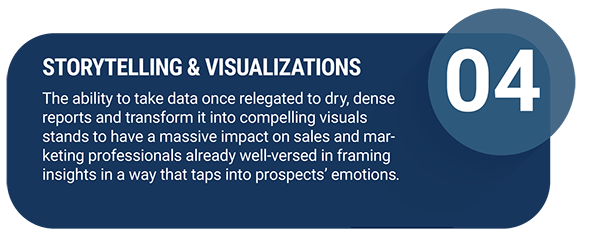
Storytelling and Visualizations: The Future of Data Analytics Has No Dashboards?
Self-service business intelligence (BI) tools are quickly replacing traditional dashboards with new capabilities designed to help end-users tell stories with data. We’re starting to see more charts, graphs, and heatmaps that can be used to present contextual insights in a way that gets people to focus on outcomes. Graph analytics create visual representations of relationships—something that could change the way we think about correlations between seemingly disparate data points.
As you might imagine, the ability to take data once relegated to dry, dense reports and transform it into compelling visuals stands to have a massive impact on sales and marketing professionals who are already well-versed in framing insights in a way that taps into prospect emotions.
This could soon become a powerful way to add value to B2B sales pitches, giving reps the ability to use data to support signing a contract while marketers might incorporate data-driven storytelling into personalized marketing efforts. Internally, visualizations will likely aid more decisions—whether that’s making the case for a new product, fine-tuning the supply chain strategy, or capitalizing on opportunities to gain a competitive advantage.
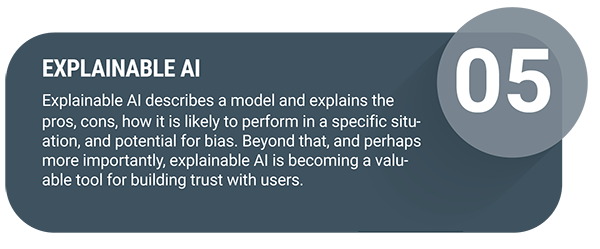
Explainable AI
Another trend that stands to bring more understanding to business intelligence is explainable AI, which describes a model and explains the pros and cons, how it is likely to perform in a specific situation, and the potential for bias. Beyond that, and perhaps more importantly, explainable AI is a valuable tool for building trust with users.
Because there’s always the risk of unintentionally feeding biased information to algorithms, augmented analytic platforms with this feature will help organizations identify instances where decisions are based on bad information or don’t put the business’s best interests first. This technology helps humans understand the path that a system took to arrive at a decision, using plain language to break down the logic.
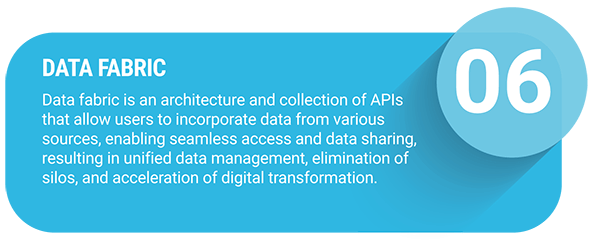
Data Fabric
According to a report from BI-Survey, data quality and management are becoming bigger challenges, as the amount of data generated continues to expand at an exponential rate. Again, this is a challenge that will only get more complicated as 5G becomes more widely available.
Data fabric is an architecture and collection of APIs that allow users to incorporate data from various sources, enabling seamless access and data sharing across a distributed network. This technology supports unified data management (including integration, governance, quality management), eliminates silos, and accelerates digital transformation. While Gartner noted in its 2020 trends report that organizations will need to commission “bespoke data fabric designs” for the next couple of years, chances are that out-of-the-box solutions will be available relatively soon.
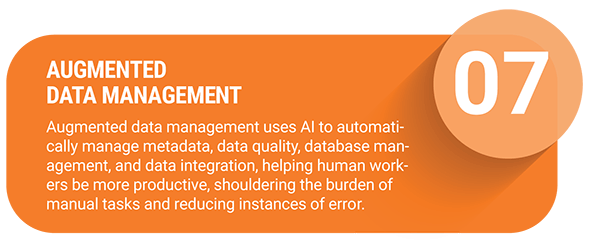
Augmented Data Management
Augmented data management uses AI and machine learning to automatically manage metadata, data quality, database management, and data integration. These technologies stand to help employees be more productive, shouldering the burden of manual tasks and reducing instances of error. Additionally, augmented data management converts the metadata used for audit trails, reporting, and data lineage into insights that help AI/ML systems further develop their capabilities.
What Does the Future of Big Data Analytics Have in Store?
In the COVID era, the future of data analytics—or anything else—is impossible to predict.
That said, if you look at the emerging data analytics trends that have continued to grow , it seems we’re on the verge of disruption. Moving forward, businesses will likely look for analytics tools that help them adapt to global crises without skipping a beat.
Augmented analytics stands to help businesses spot potential threats and emerging opportunities much earlier, even if they don’t have a dedicated data science team. And with 5G emerging, continuous intelligence streams and greater IoT adoption will make real-time analytics—and guided recommendations—more reliable and accessible, prompting faster decision-making.
[adinserter name=”Data Analytics CTA”]
Recent blog posts

Stay in Touch
Keep your competitive edge – subscribe to our newsletter for updates on emerging software engineering, data and AI, and cloud technology trends.



